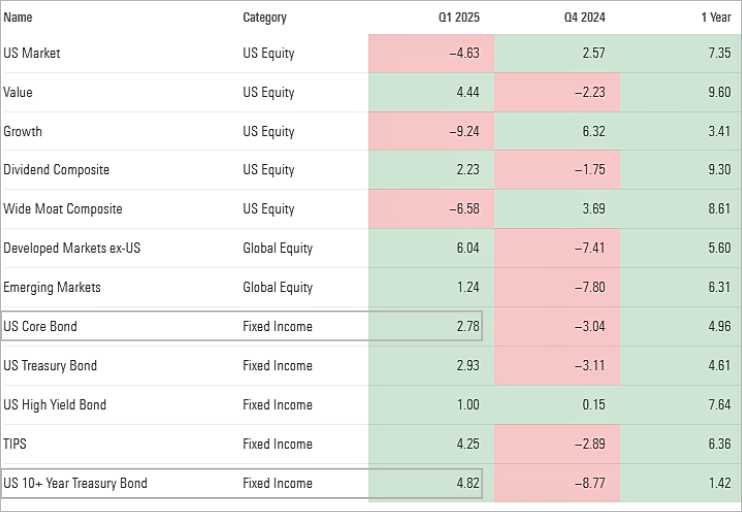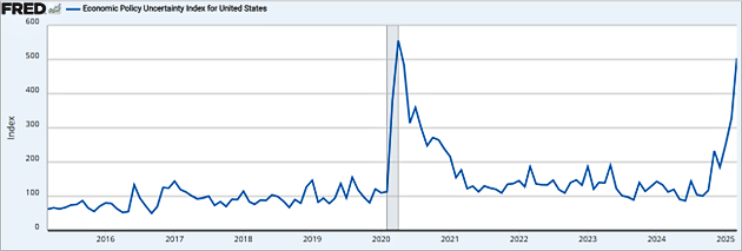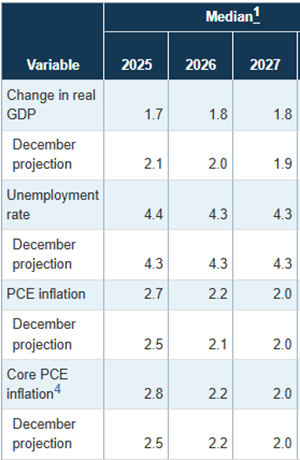After a strong start to the year, markets were jolted by rising policy uncertainty and the unexpected economic impact of new tariffs. In this Q1 recap, we unpack how initial momentum gave way to volatility, what shifting Federal Reserve projections signal for the months ahead, and how global markets and bonds responded differently than large-cap U.S. stocks.
While headlines may feel unsettling, we break down what’s behind market ups and downs—and what it may mean as we look ahead.
1st Quarter Review
Equity markets maintained their post-election momentum throughout January, achieving new all-time highs by late February. However, March brought a significant change in sentiment following two years of robust returns. The looming threat of broad-based tariffs shifted the focus away from deregulation and strong corporate earnings to concerns about a potential resurgence of inflation and increasing recession risk. This transition was marked by heightened market volatility and a selloff in stocks as participants adjusted to the evolving economic landscape.
Equity and Fixed Income Review
While both U.S. and international stocks saw gains through much of January and February, the threats of tariffs caused a momentum shift that resulted in a decline of over 10% in large-cap U.S. stocks by the end of March. Overall, U.S. equities finished the quarter down 4.63% for the year, with larger technology stocks experiencing a notable downturn of 9.24%. Conversely, diversified portfolios were somewhat insulated from larger losses, as U.S. value stocks ended the quarter up 4.44%. Developed international and emerging market equities also outperformed the U.S., closing the quarter with gains of 6.04% and 1.24%, respectively. Bonds acted as a safe haven for investors, with prices rising even as the Federal Reserve chose not to lower interest rates, leading core bonds to finish the quarter up 2.78% and the 10-year Treasury increasing nearly 5%.

Source: Morningstar Direct Data as of March 31, 2024. Performance in %.
Peak Policy Uncertainty?
Policy uncertainty has emerged as a significant barrier, impacting sentiment among consumers and businesses alike. The accompanying chart from the Federal Reserve illustrates that policy uncertainty has reached its highest level since the pandemic. This index measures economic uncertainty arising from changing policies expected to impact the economy.

Source: FRED.org
Accumulated shifts in policy since the beginning of the year, primarily pertaining to tariffs, but also immigration, and federal workforce reductions, have contributed to the prevailing uncertainty. Many of the policies currently being implemented are expected to hinder growth and elevate inflation and unemployment in the short term as consumers, corporations, and financial markets adjust to a changing landscape. And, as the chart below shows, the Federal Reserve has revised its short-term outlook to account for the possibility of slower growth and rising inflation.
Originally, the Fed projected a strong U.S. economy as we entered 2025, with real GDP projected to grow 2.1%, inflation expected to decelerate to 2.5% and unemployment remaining relatively low at 4.3%. However, during their March 2025 meeting, these forecasts were adjusted downward to reflect expectations of slower GDP growth (1.7%), higher inflation (2.7%), and increased unemployment (4.4%):

Source: FOMC Summary of Economic Projections
And while these revisions show an economy facing headwinds, they do not suggest an impending recession. Nonetheless, market volatility has intensified as financial markets try to factor in implications of much higher tariff regime on the U.S. and Global economy.
Understanding Tariffs
Even casual news observers are now familiar with tariffs, a topic frequently discussed due to its potential impact on all U.S. consumers and businesses. In simple terms, tariffs are taxes imposed by the government on imported goods such as cars, furniture, or food. While they do boost government revenue, tariffs can also slow economic growth. The extent of this slowdown remains uncertain, particularly as specific tariff levels are yet to be fully negotiated. Although many economists are not forecasting a recession, they are increasingly acknowledging the possibility of one occurring sooner rather than later.
Economist Sonal Desai from Franklin Templeton has provided a straightforward perspective on how tariffs could affect the U.S. economy. She suggests that an average tariff rate of 12-18% on all imported goods would essentially translate to a sales tax increase of 2-3%. While public outcry would likely be significant if a national sales tax of 3% were introduced, Desai notes that analysts and economists would generally expect a one-time hit to GDP growth and an immediate rise in inflation, without widespread predictions of a recession.

Source: https://www.franklintempleton.com/articles/2025/fixed-income/
Tariffs, Volatility and Staying the Course
The first quarter of 2025 saw a dramatic shift in policy uncertainty leading to volatility in capital markets. And while increased tariffs seem like they are here to stay, if the tariff rates currently announced lead to the equivalent of a 2%-3% sales tax as the above analysis suggests, that alone may not trigger a recession. Additionally, any news announcements regarding tariffs reductions may be viewed positively by capital markets, which have started pricing in recession risks over the past few weeks.
We anticipate that challenges and volatility will persist in the upcoming quarter, which we will continue to monitor closely. Our focus remains on assisting clients in navigating this environment while working toward their long-term objectives.
The views expressed do not necessarily represent those of Private Client Services, their employees or their clients.
































0 Comments